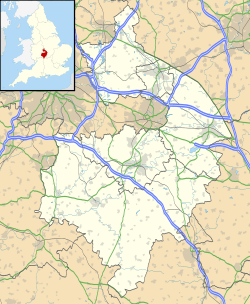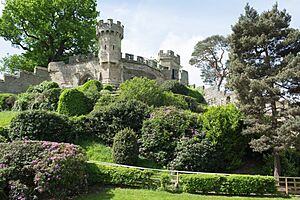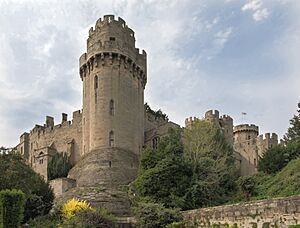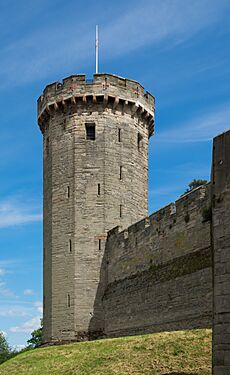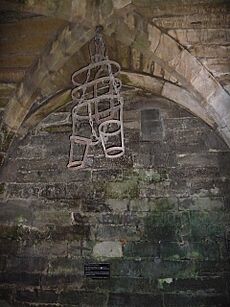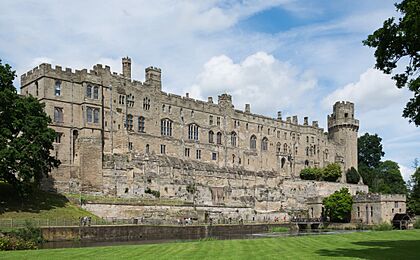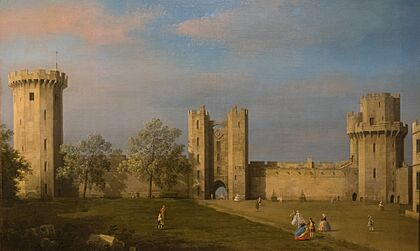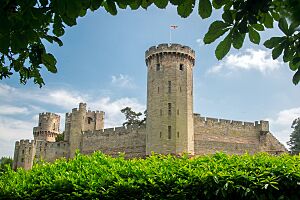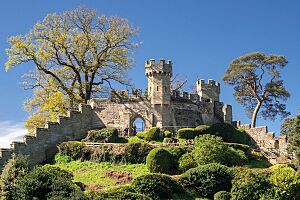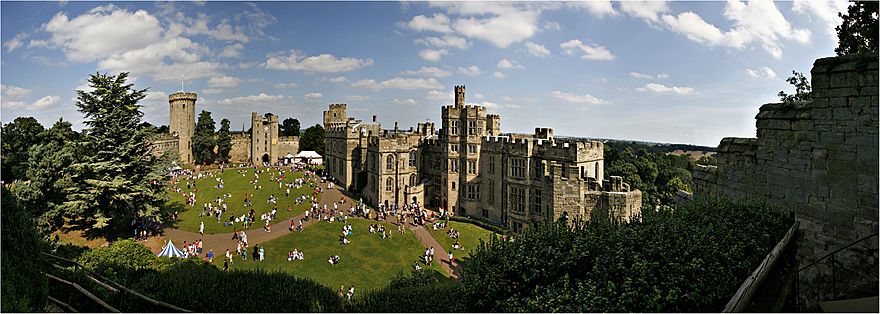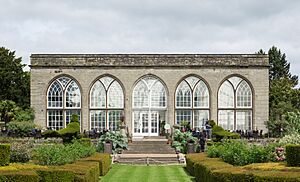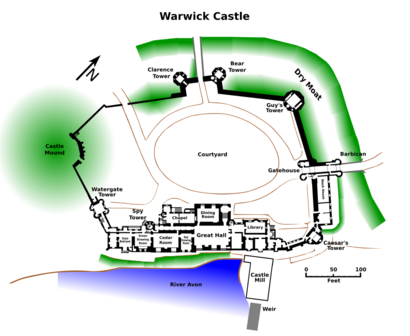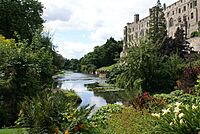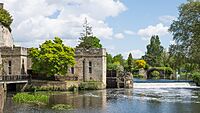Warwick Castle facts for kids
Quick facts for kids Warwick Castle |
|
|---|---|
| Warwick in England | |
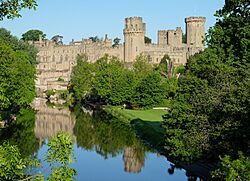
Warwick Castle and the River Avon
|
|
|
Shown within Warwickshire
|
|
| Coordinates | 52°16′46″N 01°35′05″W / 52.27944°N 1.58472°W |
| Site information | |
| Owner | LXi REIT |
| Operator | Merlin Entertainments |
| Open to the public |
1978 |
| Site history | |
| Built | 1068 |
| Materials | Stone |
Warwick Castle is an amazing medieval castle in Warwick, England. It was first built as a wooden fort by William the Conqueror in 1068. Warwick is the main town of Warwickshire and sits by the River Avon.
The first wooden castle was later rebuilt with strong stone walls in the 1100s. During the Hundred Years' War, the part of the castle facing the town was made even stronger. This made it a great example of 14th-century castle design. It was used as a stronghold (a fortified place) until the early 1600s.
In 1604, King James I gave the castle to Sir Fulke Greville. He turned it into a grand country house. The Greville family, who later became the Earls of Warwick, owned it until 1978. Then, the Tussauds Group bought it.
Today, Warwick Castle is owned by LXi REIT and operated by Merlin Entertainments. It is a very popular tourist attraction, known for its history and fun activities.
Contents
Where is Warwick Castle?
Warwick Castle is located in the town of Warwick. It sits on a sandstone bluff (a steep rock face) next to a bend in the River Avon. The river flows below the castle on its east side. Over time, the river has worn away the rock, creating a natural cliff. Both the river and the cliff act as natural defenses for the castle.
When the castle was first built in 1068, four houses were removed to make space for it. The castle's location was very important. It helped protect the Midlands region of England from rebellions.
Warwick Castle is easy to reach. It's about 1.6 kilometers (1 mile) from Warwick railway station. It's also close to a major motorway and Birmingham Airport.
Castle History
Early Days
An Anglo-Saxon fort, called a burh, was built on this site in 914. It was set up by Æthelflæd, who was the daughter of Alfred the Great. This fort was one of ten that helped defend Mercia from invading Danes. Its position was perfect for controlling the Fosse Way (an old Roman road) and the River Avon valley.
There is a mound to the southwest of the castle called "Ethelfleda's Mound." However, this mound is actually part of the later Norman castle, not the original Anglo-Saxon fort.
Around this time, Warwick School was also founded at the castle. This makes it one of the oldest boys' schools in the country! It is now located just across the River Avon, and you can see it from the castle's towers.
The Middle Ages
After the Norman conquest of England, William the Conqueror built a new castle at Warwick in 1068. This was a motte-and-bailey castle. It helped him keep control as he moved north. Building a castle often meant tearing down existing homes. At Warwick, four houses were removed for the castle.
A motte-and-bailey castle has two main parts. There's a large mound (the motte) where a keep or tower usually stands. Then there's a courtyard (the bailey) that is enclosed by walls.
William II made Henry de Beaumont the first Earl of Warwick in 1088. Henry was in charge of the castle. He also founded a church inside the castle walls. But in 1127, the Bishop of Worcester moved the church. He thought a castle was not the right place for a church.
In 1153, Gundreda de Warenne was tricked into thinking her husband, Roger de Beaumont, 2nd Earl of Warwick, had died. She then gave the castle to Henry of Anjou, who later became King Henry II. It's said that Roger de Beaumont died when he heard his wife had given away the castle. King Henry II later returned the castle to the Earls of Warwick. They had supported his mother during a civil war.
During King Henry II's rule (1154–89), the wooden motte-and-bailey castle was replaced with a stone one. This new castle had a shell keep. All the buildings were built against the outer curtain wall. During a rebellion in 1173–74, the Earl of Warwick stayed loyal to the King. The castle was used to store supplies.
The castle was passed down through the Beaumont family until 1242. After Thomas de Beaumont, 6th Earl of Warwick, died, his sister Margaret de Beaumont, 7th Countess of Warwick inherited it. While she was finding a new husband, King Henry III of England owned the castle. When she married, the castle was returned to her.
During the Second Barons' War in 1264, William Mauduit, 8th Earl of Warwick, supported King Henry III. Forces from Simon de Montfort, 6th Earl of Leicester, attacked and took the castle by surprise. They even damaged some of the castle walls. Mauduit and his wife were held captive until a ransom was paid.
After Mauduit died, the castle went to his nephew, William de Beauchamp, 9th Earl of Warwick. The Beauchamp family owned the castle for the next 180 years. They added many parts to the castle. In 1312, Piers Gaveston, 1st Earl of Cornwall, was captured by Guy de Beauchamp, 10th Earl of Warwick. He was held at Warwick Castle before his execution.
Under Thomas Beauchamp, 11th Earl of Warwick, the castle's defenses were greatly improved between 1330 and 1360. They added a strong gatehouse, a barbican (a fortified entrance), and two large towers. These towers were named Caesar's Tower and Guy's Tower. The Watergate Tower also dates from this time.
Caesar's and Guy's Towers were designed for living. They have machicolations (openings for dropping things on attackers). Caesar's Tower has a unique double parapet (a low protective wall). Both towers have stone vaulted ceilings on every floor. Caesar's Tower also had a dark basement dungeon. Local stories say it was called Poitiers Tower because prisoners from the Battle of Poitiers in 1356 might have been held there. Or, the money from those ransoms helped build it.
The gatehouse was very well protected. It had murder holes, two drawbridges, a gate, and portcullises (heavy metal or wooden gates). The towers of the gatehouse also had machicolations.
The side of the castle facing the river was built to show off the power and wealth of the Beauchamp earls. It wasn't mainly for defense. This shows that castles in the 1300s were becoming more about showing power than just for fighting.
The 1400s and 1500s

The Beauchamp family's ownership ended in 1449 when Anne de Beauchamp died. Richard Neville, known as the Kingmaker, became the next Earl of Warwick through his wife. In 1469, Neville rebelled against King Edward IV of England and imprisoned him in Warwick Castle. Neville tried to rule in the King's name. But the King's supporters forced him to release Edward. Neville was later killed in battle in 1471 during the Wars of the Roses.
Warwick Castle then went to Neville's son-in-law, George Plantagenet, Duke of Clarence. He was King Edward IV's brother. George Plantagenet was executed in 1478. His lands went to his young son, Edward Plantagenet, 17th Earl of Warwick. But Edward was only two, so the King took control of his lands. Edward was held in the Tower of London for 14 years. He was executed in 1499 for supposedly planning to escape. Edward was the last Earl of Warwick from this first creation of the title.
In the early 1480s, King Richard III of England (another son-in-law of Neville) started building two gun towers: Bear and Clarence Towers. They were not finished when he died in 1485. These towers had their own well and ovens. They could act as a separate fort within the castle, perhaps in case the soldiers rebelled. With the invention of gunpowder, a new job was created in 1486: Keeper of the Artillery.
When the historian John Leland visited the castle between 1535 and 1543, he wrote about its condition. He noted that the dungeon was in ruins. He also mentioned that the main living areas, hall, and chapel were on the south side. The King was spending a lot of money to fix the foundations there because large pieces of rock were falling off.
While the Crown owned Warwick Castle, it was repaired and renovated. About 500 loads of stone were used. The castle was owned by the Crown from 1478 until 1547. Then, it was given to John Dudley, 1st Duke of Northumberland. He became the Earl of Warwick. Dudley said the castle was "not able to lodge a good baron with his train." He noted that one side and the dungeon tower were "clearly ruined."
Despite his comments, Dudley did not make any repairs. Queen Elizabeth I visited the castle in 1566 and again in 1572. A wooden building was put up for her to stay in. Ambrose Dudley, 3rd Earl of Warwick, let the Queen use the castle during her visits.
When Ambrose Dudley died in 1590, the title of Earl of Warwick ended for the second time. A survey from 1590 showed the castle was still in bad shape. It noted that lead had been stolen from the roofs of some buildings, including the chapel.
A Country House in the 1600s
In 1601, Sir Fulke Greville wrote that the castle was falling apart. He said the stone buildings were very old, and the wooden lodgings built for Queen Elizabeth I were ruined. He thought soon there would be nothing left but the name of Warwick.
King James I gave the ruined Warwick Castle to Greville in 1604. Greville turned it into a comfortable country house. Many castles in the 15th and 16th centuries were either left to decay or changed into homes.
While the castle was being fixed, it was involved in the Gunpowder Plot of 1605. The plotters waited for news of their plan in a nearby town. When they found out it failed, they stole horses from Warwick Castle's stables to escape.
When the title of Earl of Warwick was created for the third time in 1618, the Greville family still owned the castle. Fulke Greville, who became Baron Brooke in 1621, spent a lot of money renovating the castle. He lived in the Watergate Tower. A historian named William Dugdale said Greville made it "a place not only of great strength but extraordinary delight." He added that it had "most pleasant gardens, walks and thickets."
On September 1, 1628, Fulke Greville was murdered by his manservant. The servant stabbed him after finding out he wasn't mentioned in Greville's will. Greville died four weeks later. The Watergate Tower is now known as the Ghost Tower. People say his ghost haunts it.
Under Robert Greville, 2nd Baron Brooke, Warwick Castle's defenses were improved from January to May 1642. This was to prepare for an attack during the First English Civil War. The garden walls were made taller. Barricades for artillery were built. Gunpowder and wheels for two cannons were brought in.
Robert Greville supported the Parliamentarians. On August 7, 1642, a Royalist army attacked the castle. Greville was not there. The castle was defended by Sir Edward Peyto. The Royalist commander asked them to surrender, but they refused. The Royalists fired at the castle, but it didn't do much damage. One account says they shot from the church steeple, but it only "frightened them within the castle." The defenders shot back and killed some Royalist soldiers.
The siege ended on August 23, 1642. The castle defenders were helped by the forces of the Earl of Essex. The Royalists had to retreat. After the Battle of Edgehill in 1642, prisoners were held in Caesar's and Guy's Towers.
During the Second English Civil War, more prisoners were held at the castle. This included those from the Battle of Worcester in 1651. A group of soldiers, called a garrison, stayed at the castle from 1643 to 1660. At its strongest, there were 302 soldiers. In 1660, the government ordered the castle governor to send the soldiers away. The castle was given back to Robert Greville, 4th Baron Brooke. The main living areas were old-fashioned and needed repairs.
Between 1669 and 1678, the castle's interiors were greatly updated. Master carpenters Roger and William Hurlbutt worked on it. William even went to another grand house to learn about the latest styles. On November 4, 1695, King William III visited the castle.
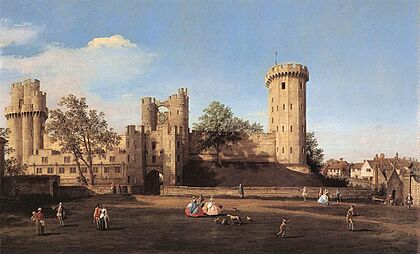
Francis Greville, 8th Baron Brooke, started new improvements to Warwick Castle and its grounds. He also became the Earl of Warwick in 1759. This meant the castle was again owned by the Earls of Warwick.
Daniel Garrett worked on the castle's Gothic-style chapel interior in 1748. Lancelot "Capability" Brown, a famous landscape designer, started working on the grounds in 1749. Brown made the castle's connection to the river look more natural. He created a sweeping lawn that went right down to the riverbank. He also added a winding drive to make the entrance feel further away.
In 1751, Horace Walpole saw Brown's work and said, "The castle is enchanting." He loved the view, especially the River Avon flowing over a waterfall at the castle's base.
In 1754, the poet Thomas Gray was not so impressed. He thought the changes were too modern for a castle. He said they added "whimwams" inside the windows to make them look Gothic. He also said they made a small area for the family that looked like a modern city house.
Greville asked the Italian painter Antonio Canaletto to paint Warwick Castle in 1747. This was while Brown was landscaping the grounds. Canaletto painted five pictures and made three drawings of the castle. This makes it the most painted building in Britain by him. Canaletto's work on Warwick Castle is special because it's a series of views of an English house by a major European artist.
Brown also designed a wooden bridge over the Avon in 1758. He was still working on the castle in 1760. Other architects added to the castle in the 1760s. In 1786–88, a new greenhouse conservatory was built. Its main feature was the Warwick Vase, which had recently been bought in Rome.
In 1802, George Greville, 2nd Earl of Warwick, had large debts. His estates, including Warwick Castle, were given to others in 1806. But the castle was returned to the Earls of Warwick in 1813. The Great Hall was repaired and given a new roof in a Gothic style in 1830–31. The Watergate Tower was restored in 1861–63.
A fire badly damaged the castle in 1871. It started east of the Great Hall. The fire was set on purpose by the under-butler and an accomplice. They stole valuables and then set the fire to hide the robbery. The Great Hall and private rooms were destroyed inside, but the main structure was okay. Repairs were done between 1872 and 1875. Money for the repairs came from public donations.
Warwick Castle Today: A Tourist Attraction
People have been visiting Warwick Castle since the late 1600s. This became even more popular in the 1800s. In 1858, Queen Victoria visited the castle. There were big celebrations in the town. However, by 1885, visitors were causing problems, so the earl closed the castle. This upset many people, especially American tourists. But it soon reopened. By 1900, it had a ticket office and a permanent guide.
By 1936, writer Arthur Mee praised the castle. He said its walls had seen "splendour of every generation" of English history. He also noted that its rooms were "rich in treasure" and "open to all."
Throughout the 1900s, the earls worked to make the castle even better for tourists.
New Ownership and Fun Activities
In 1967, Charles Greville, 7th Earl of Warwick, gave the castle to his son, Lord Brooke. In 1978, Lord Brooke sold the castle to the Tussauds Group for £1.3 million. The Greville family had owned the castle for 374 years. The sale caused a public disagreement between father and son.
Tussauds continued to use the castle mainly as a tourist attraction. They made many repairs and improvements to the castle and its grounds. In 12 of the rooms open to visitors, you can see wax figures of famous historical people. These figures show guests at a party in 1898 hosted by Frances, Countess of Warwick. The main guest was the Prince of Wales, who later became Edward VII.
The collection of armor at Warwick Castle is considered one of the best, second only to the Tower of London.
In 2001, Warwick Castle was named one of Britain's "Top 10 historic houses and monuments." It was also recognized as Britain's best castle in the Good Britain Guide 2003. Around this time, it was getting over half a million visitors each year.
In 2007, the Tussauds Group sold the castle to Blackstone Inc.. Then, Merlin Entertainments started operating it. Later that year, Warwick Castle was sold again to the Prestbury Group. But Merlin still operates it under a long-term lease.
Seasonal Shows and Events
Warwick Castle offers many exciting attractions for visitors. These include:
- "Falconer's Quest": A bird show with amazing birds like bald eagles, vultures, and sea eagles.
- Archery displays.
- Jousting tournaments.
- "The Trebuchet Show": Featuring a giant siege engine.
- "The Sword in the Stone Show".
- "The Castle Dungeon": A live actor experience similar to "London Dungeons."
Warwick Castle is also known for its ghost stories. One famous ghost is Fulke Greville, who is said to haunt the Watergate Tower. The castle uses its haunted reputation for tourist events like "Warwick Ghosts Alive." This is a live show about Fulke Greville's murder. The castle also hosts musical events, like carolling.
In Summer 2018, the castle had a "War of the Roses" event with jousting. On some August dates, "Dragon Slayer" evenings were held. These included dining, a light show, fireworks, fire jousting, and live stunts.
Protecting the Castle
Warwick Castle is a very important historical site. It is protected as a scheduled monument. This means it's a "nationally important" archaeological site or historic building. It is also a Grade I listed building. This protection includes its walls, stables, conservatory, mill, and lodge.
In 2006, a valuable stained glass window was damaged by vandals. A ceremonial sword was also stolen but was found soon after.
The Warwick Castle Trebuchet
In June 2005, Warwick Castle became home to one of the world's largest working siege engines. This is a trebuchet. It stands 18 meters (59 feet) tall and weighs 22 metric tons (24 short tons). It's made from over 300 pieces of oak. You can find it on the riverbank below the castle.
The trebuchet was built using drawings from a Danish museum called Middelaldercentret. This museum was the first to build a working trebuchet in 1989. The Warwick Castle trebuchet was built in Wiltshire, England, with help from the Danish experts.
It takes eight men half an hour to load and fire the trebuchet. Four men run in large treadwheels to lift the 6-ton (6.6 short tons) counterweight into the air. The trebuchet can throw objects weighing up to 150 kilograms (330 pounds) as far as 300 meters (980 feet). It can also throw them as high as 25 meters (82 feet).
On August 21, 2006, the trebuchet set a record. It threw a 13-kilogram (29-pound) object 249 meters (817 feet) at 195 kilometers per hour (121 mph). This beat the previous record held by the trebuchet in Denmark.
On April 10, 2015, a thatched boathouse caught fire. This happened shortly after a burning cannonball was fired by the trebuchet. It was thought that a spark from the cannonball started the fire. Hundreds of tourists were evacuated, but they were not in danger. The boathouse was described as "historic" and built in 1896.
The trebuchet was taken out of service in 2020 due to safety concerns. It was taken apart and replaced with a similar trebuchet in 2023.
Castle Design
The current stone castle was built during King Henry II's reign. It stands on the same spot as the earlier Norman motte-and-bailey castle. A keep (a strong tower) used to be on the motte (the mound) in the southwest. Most of that structure is now from later periods. In the 1600s, a path was added to the motte. The bailey (courtyard) was included in the new castle and is surrounded by stone walls.
When Warwick Castle was rebuilt under King Henry II, its layout changed. The buildings were placed against the outer walls. The castle has a dry moat (a ditch without water) on its northern side. This is where there's no natural protection from the river or the old mound. The walls are about 130 meters (140 yards) long and 82 meters (90 yards) wide.
The castle has two entrances, in the north and west walls. There used to be a drawbridge over the moat in the northeast. In the middle of the northwest wall is a gateway with Clarence and Bear's towers on either side. These were added in the 1400s to make the castle stronger. The main living buildings are on the eastern side of the castle, facing the River Avon. These include the great hall, library, bedrooms, and chapel.
Who Owned Warwick Castle?
Over its 950-year history, Warwick Castle has had 36 different owners. It was also owned by the Crown (the King or Queen) seven times. It was the family home for three different groups of Earls of Warwick. Families like the Beaumont, Beauchamp, Neville, Plantagenet, Dudley, and Greville families lived there.
The first time the Earldom was created, women could inherit the title. So, three times, a woman or girl owned the castle. Eleven owners were under 20 when they inherited, including a two-year-old girl and a three-year-old boy. At least three owners died in battle, two were executed, and one was murdered. Every century except the 21st has seen major building work or changes at the castle.
Gardens, Park, and Places to Stay
Formal gardens at Warwick Castle were first mentioned in 1534. In the 1600s, spiral paths were added to the castle mound during Fulke Greville's restoration. Capability Brown was hired by Francis Greville to redesign the castle grounds. He worked on them from 1749 to 1757, spending a lot of money on the project. The gardens cover 2.8 square kilometers (690 acres). Robert Marnock created more formal gardens in 1868–69.
Castle Park, located south of the castle, was started in 1743. It was first called Temple Park because the Knights Templar used to own land there. Houses around the park were removed to make it larger. In the late 1700s, people tried to make money from the park by using it for grazing animals and growing wheat.
A water-powered mill in the castle grounds was likely built by Henry de Beaumont. By 1398, the mill was moved just outside the eastern castle walls, by the River Avon. Both mills often flooded. By 1644, an engine house was added to the mill. The mill later generated electricity. But once Warwick Castle got mains electricity in 1940, the mill was no longer needed and was taken down in 1954.
Today, you can even stay overnight at the castle! One option is glamping (glamorous camping) in decorated tents in an area called Knight's Village. These tents don't have cooking facilities, so dinner and breakfast are included. You can also stay in timber lodges in the Woodland Hideaway area.
See also
 In Spanish: Castillo de Warwick para niños
In Spanish: Castillo de Warwick para niños
- Castles in Great Britain and Ireland
- Kenilworth Castle
- List of castles in England
- List of owners of Warwick Castle
- Old Castle Bridge - a ruined medieval bridge next to the castle


